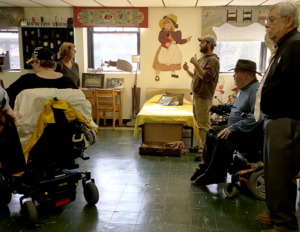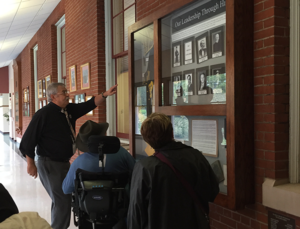
In 1868, young Henry Bell came to Third United Presbyterian Church’s Mission Academy School. Henry was African American and deaf. The pastor solicited Pittsburgher William Drum, who was also deaf and a graduate of the Pennsylvania Institution in Philadelphia, to teach him. This effort quickly expanded, and a school opened in September 1869.It was the first day school for deaf children in the United States.
Today, that school, the Western Pennsylvania School for the Deaf (WPSD), is in the process of gathering and displaying artifacts and documents from their nearly 150 years as educators. Western Pennsylvania Disability History and Action Consortium members recently visited to see the collection.
Chris Noschese, a Consortium steering committee member who taught at WPSD for 35 years, helped arrange the meeting. Bobby Maher, an alumnus and current school staffer, and Matthew Campion, director of institutional advancement, led a tour of the school’s museum, which they describe as a work in progress.
The Consortium is helping arrange a future visit by experts from the Heinz History Museum who can advise the school on the best ways to preserve and catalog their history.

A Pictorial History of the Western Pennsylvania School for the Deaf includes a 1901 quote by an editor the school newspaper, The Western Pennsylvanian:
“…current issues may seem to contain little that is of interest because it is simply a record of everyday life in school and nearly or quite all the ‘news’ is known before it is published…. the paper is the history of the school and in years to come it will be valuable.”
Clearly, WPSD already had a sense of the importance of preserving history. The school is working today to create an in-house museum, including technology used over the years, dorm-room furniture, toys, sports equipment, clothing, and more, along with photographic displays of the school’s buildings and other history. The school also has extensive photo and publication archives.
A few facts:
- Established in 1869, the school moved several times before settling at its current location in Edgewood in 1884.
- In 1899, the school’s main building burned down. It was rebuilt by 1902, and still serves as the school’s main building.
- The school began as a day school, but later added residential students. Today, about 40 percent of the school’s 180 students are residential.
- A full-service printing operation provides services to internal and external clients while also providing educational and employment opportunities. A well-equipped broadcast studio is used by students to generate a school news show and other programming.
The Consortium looks forward to supporting WPSD as they plan for their 150th anniversary in 2019.
This WPDHAC.org article source is published on November 15, 2017.